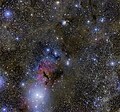|
NGC 1333
NGC 1333 is a reflection nebula located in the northern constellation Perseus, positioned next to the southern constellation border with Taurus and Aries.[3] It was first discovered by German astronomer Eduard Schönfeld in 1855.[4] The nebula is visible as a hazy patch in a small telescope, while a larger aperture will show a pair of dark nebulae designated Barnard 1 and Barnard 2.[5] It is associated with a dark cloud L1450 (Barnard 205). Estimates of the distance to this nebula range from 980–1,140 ly (300–350 pc).[4] This nebula is in the western part[4] of the Perseus molecular cloud and is a young region of very active star formation,[6] being one of the best-studied objects of its type.[4] It contains a fairly typical hierarchy of star clusters that are still embedded in the molecular cloud in which they formed,[7] which are split into two main sub-groups to the north and south. Most of the infrared emission is happening in the southern part of the nebula. A significant portion of the stars seen in the infrared are in the pre-main sequence stage of their evolution.[6] The nebula region has a combined mass of approximately 450 M☉,[4] while the cluster contains around 150 stars with a median age of a million years and a combined mass of 100 M☉. The average star formation rate is 1×10−4 M☉ yr–1.[4] Within the nebula are 20 young stellar objects producing outflows, including Herbig–Haro objects, and a total of 95 X-ray sources that are associated with known members of embedded star clusters.[6] In 2011 researchers reported finding 30 to 40 brown dwarf objects in the cloud and in the Rho Ophiuchi cloud complex.[8] 15 objects with a spectral type of M9 or later were discovered in NGC 1333. This spectral type corresponds to a mass of a planetary-mass object (PMO) at the age of NGC 1333. About 42% of the PMO are surrounded by a circumstellar disk, but only one out of six objects with a spectral type of L0 (about 10 MJ) or later has a disk. Scholz et al. argues that this indicates that very low mass PMOs form like planets (aka ejected planets) and not like stars (also called sub-brown dwarfs).[9] Parker & Alves de Oliveira on the other hand argue that the distribution of PMOs in NGC 1333 follows N-body simulations of objects that form like stars and that none of the PMOs has a peculiar motion, which is predicted for ejected planets. They also note that ejected planets are hiding in this and other star-forming regions.[10] Additional PMOs were discovered by Scholz et al. 2012 with Subaru (e.g. SONYC-NGC1333-36 with estimated 6 MJ)[11] and by Langeveld et al. 2024 with JWST (6 objects and one JuMBO candidate). Langeveld et al. did not find any object below 4 MJ, despite JWST being sensitive enough to detect these objects. This could mean that star-formation does not occur below 4 MJ, which is consistent with previous observations in most star-forming regions and the nearby stellar population. One source, called NIRISS-NGC1333-5 (NN5), shows infrared excess, which is an indication of a disk around the object. With a mass of 5 MJ, this object could be one of the lowest mass object with a disk known so far.[12] Gallery
References
External linksWikimedia Commons has media related to NGC 1333.
|
||||||||||||||||||||||

![A small region of NGC 1333 taken by Hubble Space Telescope.[13] The bi-polar object in the upper part is HH 4](http://upload.wikimedia.org/wikipedia/commons/thumb/f/f6/NGC_1333_Champions_League.jpg/117px-NGC_1333_Champions_League.jpg)
![There are 5 Herbig–Haro objects (numbered 7 to 11) in this image, which are located in the southern part of NGC 1333.[14]](http://upload.wikimedia.org/wikipedia/commons/thumb/c/c5/The_smoking_gun_of_a_newborn_star.jpg/117px-The_smoking_gun_of_a_newborn_star.jpg)



